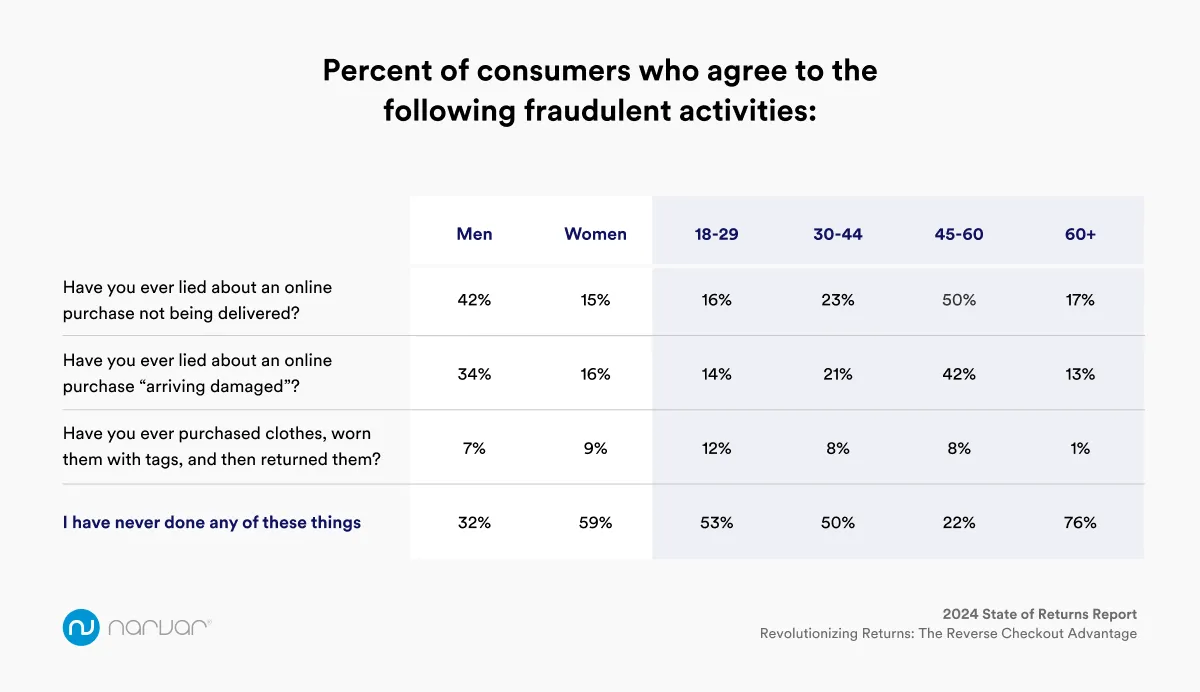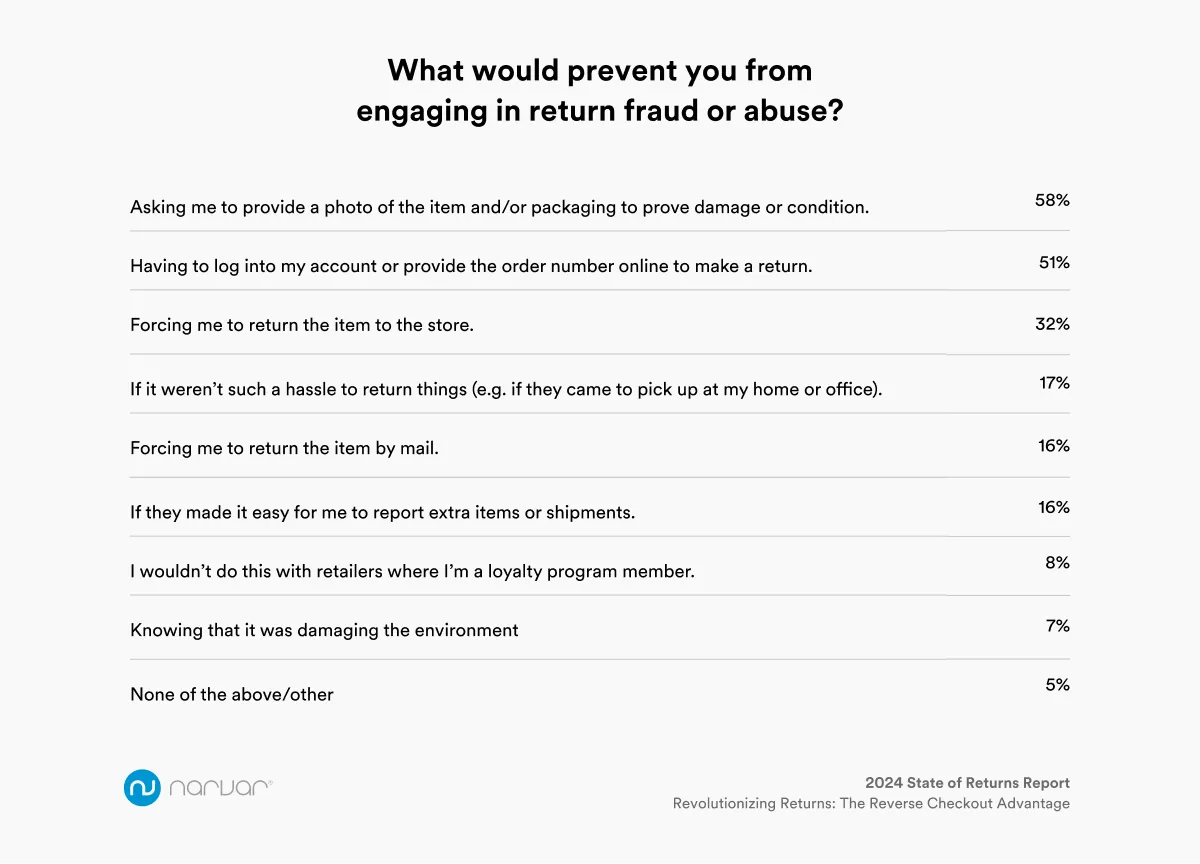
AI-powered delivery date estimates to boost conversion
Give shoppers peace of mind and protect and grow your bottom line
Personalized tracking experiences to build brand loyalty
Returns and exchanges management to mitigate fraud and reward best customers
Proactive communication to drive customer lifetime value
Delivery claim management to tackle fraud and build trust
What is Retail Return Fraud? Types of Fraud & How to Prevent It
.webp)
Retail return fraud can’t be ignored any longer. In our 2024 State of Returns report, 52% of shoppers admitted to engaging in return fraud at least once in their lifetime—a sharp increase from 36% just a year ago. Let’s dive into the examples of return fraud, and what brands can do at scale to prevent and manage the problem.
What is Retail Return Fraud?
Retail return fraud is the act of deceiving retailers to gain financial advantage. It involves a range of deceptive practices during the return process. Unfortunately, these fraudulent behaviors are alarmingly prevalent. The most common fraudulent activities?
- 31% of consumers confessed to lying about an online purchase not being delivered.
- 27% of consumers admitted to falsely claiming that an online purchase arrived damaged.
Even more concerning, among those who have engaged in return fraud, 45% committed such acts within the last week, and 24% did so in the past month. Combined, 69% of fraudsters admitted to engaging in fraudulent activities in the last month. Compared to the 38% that admitted to monthly return fraud last year, we saw an increase of 31 percentage points. This trend underscores the growing sophistication and frequency of return fraud.
Types of Retail Return Fraud
There are a few different types of return fraud to look for.
Return Fraud #1: Lying About a Purchase Not Being Delivered to Receive a Refund
One of the most prevalent forms of return fraud involves consumers falsely claiming that an item was never delivered. Again, 31% of consumers have admitted to doing this in their lifetime.
This deception allows individuals to obtain a refund or replacement without ever returning the actual product. With the rise of e-commerce, where tracking and delivery verification systems are crucial, some fraudsters exploit these processes by fabricating stories of undelivered goods. They may argue that they never received a package or provide a false shipping address. Retailers must be vigilant and utilize robust tracking systems and confirmation receipts to minimize this type of fraud.
Specifically, consider implementing Visual Proof of Delivery (VPOD) confirmation with carriers that offer it. These carriers will now take photos of packages upon delivery, which can be integrated with the tracking pages powered by Narvar.
This allows consumers and retailers to see visual proof of the packages on their doorstep or in their mail room, providing a clear record of delivery and reducing the ability of consumers to lie.

Return Fraud #2: Lying About an Online Purchase “Arriving Damaged” to Receive a Refund
Another common fraudulent tactic involves consumers reporting that an item arrived damaged, even if it was not. 27% of consumers admitted to doing this activity in their lifetime.
This claim often results in the retailer issuing a refund or replacement without requiring the return of the damaged product. Some fraudsters might use the claim of damage as a pretext to keep a product for free.
To combat this, retailers should implement stringent return policies and require detailed photographic evidence of any damage claims. Leverage a returns management system that can enable photo proof of damage before a return request is accepted. In fact, this would deter 58% of fraudsters from engaging in unwanted behavior (see details below).
Return Fraud #3: Purchasing Clothes, Wearing Them With Tags, and Then Returning Them
Another form of return fraud involves purchasing clothing, wearing it for a short period, and then returning it with the tags still attached. This practice, often referred to as "wardrobing," means that consumers use garments temporarily without paying for them.
Retailers can address this issue by enforcing stricter return policies, such as limiting the return period or implementing a restocking fee. Additionally, examining returned items closely for signs of wear can help identify and reduce the frequency of this type of fraud.

How to Prevent Retail Return Fraud
To prevent return fraud, retailers should invest in best-in-class returns management software to enable fraud-fighting functionality, automate the returns review and acceptance process, and identify suspicious return patterns. Implementing stricter return policies, such as requiring proof of purchase or limiting return windows, can also deter fraudulent behavior.
In our latest survey, we asked fraudsters what would deter their behavior. In addition to photo proof of damage, respondents also said they would be prevented from these activities if they had to log into their account or provide the order number online to make the return.

In conclusion, as return fraud becomes increasingly prevalent, it is crucial for retailers to adopt comprehensive strategies to mitigate its impact. By understanding the various types of return fraud and implementing preventive measures, businesses can protect their bottom line and ensure a fair return process for all customers and a positive customer experience.
Don’t forget! Download our 2024 State of Returns report for more information.



Related posts





















